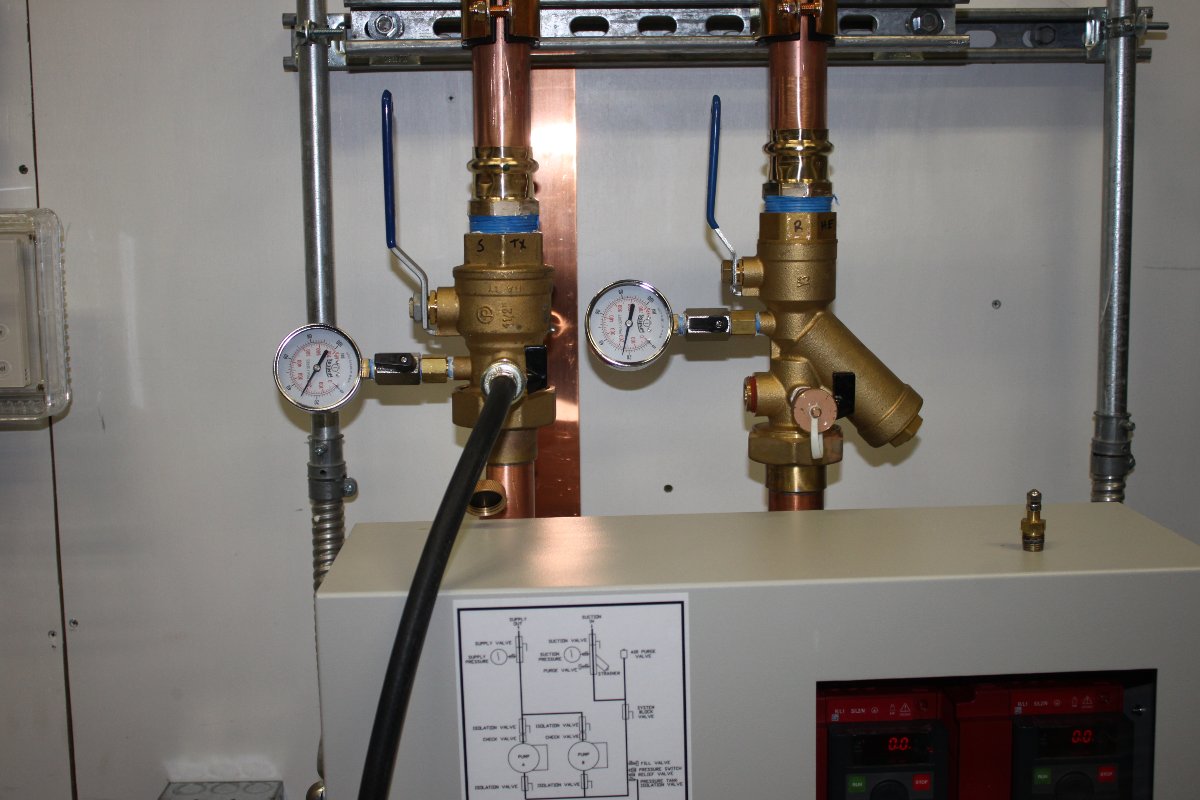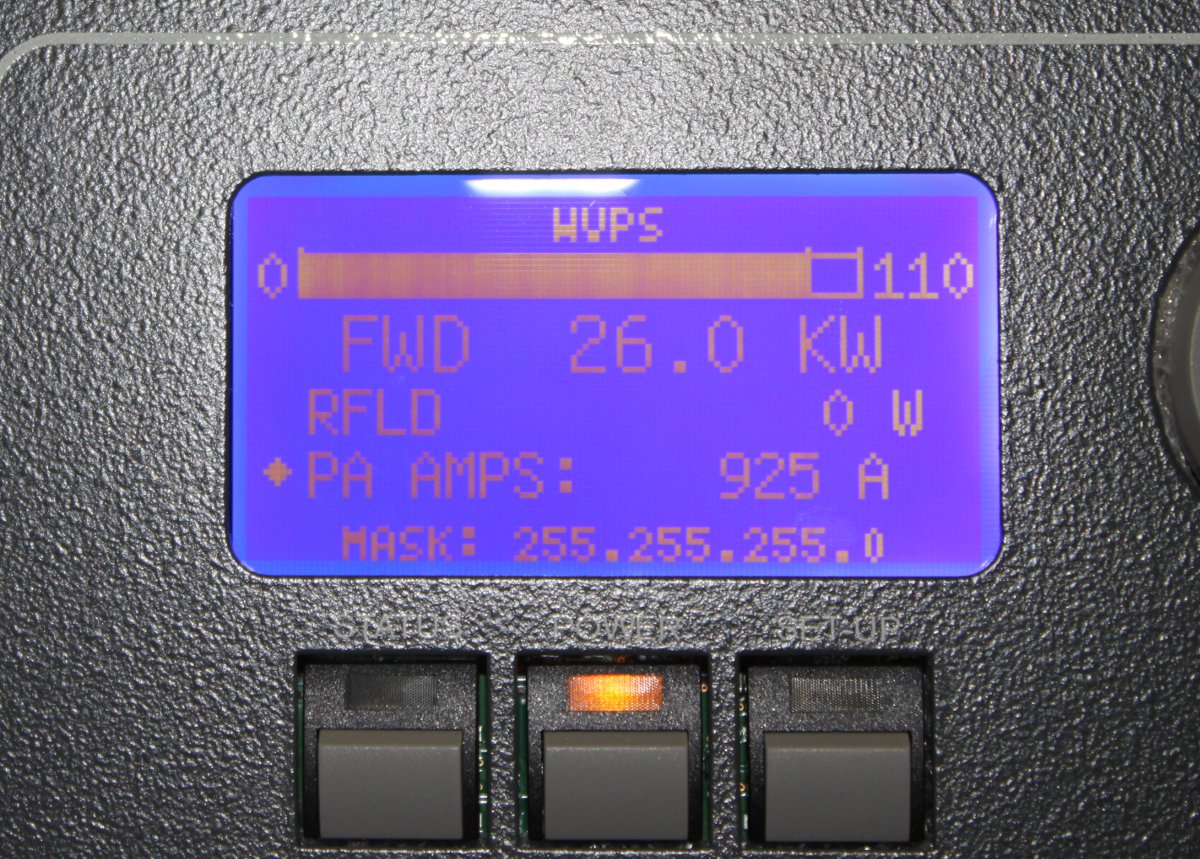This is the second time I have installed one of these liquid-cooled transmitters. This time, it is for WVPS in Burlington, VT. WVPS is the flagship station for Vermont Public Radio. The station is a full class C, a rarity in the North East. The transmitter is located on Mount Mansfield giving it a HAAT of 2,717 feet (828 Meters), which is a good way up.

This transmitter replaced the previous backup transmitter, a Harris Z16 unit from the early ’00s. There was nothing really wrong with this unit, it just was not a full power backup.

The new transmitter came in two pieces, which is typical for the 30 and 40 KW GatesAir liquid and air-cooled transmitters.

For the cooling part of this installation, 1 1/2 inch type M copper pipe was used. This matches most of the other TV transmitters down the hall. In the same building are the transmitters for WCAX-TV, WPTZ-TV, WFFF-TV, and WVNY-TV.



The highest point in the liquid-cooled system is the air purge valve and distribution manifold just above the transmitter. From here, everything slopes down to a few low points; the heat exchanger outside, the pump station, and the power blocks. This is to make it easier to drain if that ever needs to happen. There is also an air inlet valve to aid in draining.

All of the cooling work is controlled by the pump station. The fans are connected to VFD modules, which control the flow of air through the Heat Exchanger.

All of this plumbing work was greatly sped along with the use of this Pro Press pipe press tool. This thing is great! No more sweating connections. Dry fit a section to make sure that it is all cut correctly, then go to work with this and it is done in a matter of seconds. Of course, there are no re-dos, so the dry fit procedure is a little more important.

Prior to filling with Heat Transfer Fluid (50/50 water/antifreeze mix), the system was first pressure tested with air, then filled with clean water for a 12-hour flush. The water was drained out and the filter screen was cleaned, then it was filled with the appropriate Heat Transfer Fluid.

Final system checks, remote control test, and HTF top off and the transmitter is ready to go pending the HD Radio installation.








Wow…hope that Milwaukee press kit gets a lot of use going forward…that is one expensive toolkit.
We had a water leak on one of the big pipes feeding restrooms in our building a couple years ago. First time seeing a press tool in action. Pretty slick!
Checked Engineering Radio today, as usual, saw a new picture, smiled to myself, got a glass of the good stuff, sat down and read of Paul’s latest masterpiece. Love seeing your work. 35+ years in comm engineering, and I always see something interesting when I visit here, like that plumbing fitting press set…never seen one of those before.
26KW TPO into a 4-bay panel at 2700′, wow, I bet that signal really gets out!
Yes it does! WVPR is the main way folks in Montreal (some 70-80 miles NNW) can hear NPR programming.
Question: the average low temps on top of Mansfield get pretty cold in winter. Down in the single digits F, or even negative F. I thought the lower limit for the glycol mix in the heat exchangers was around 5 or 10 F. Are there external heaters?
Whoops, that should be “WVPS”, not “WVPR” – sorry!
I’ve worked for a few UHF stations over the years and we always left the pumps and the filaments on overnight during the winter months.
That generated enough heat to keep things warm and make for a painless sign-on which was far from turning over the cold diesel it would have been.
One of those stations sustained serious damage to it’s heat exchanger being off air for at least a winter between ownerships.
The plant never let us forget what it was put through for years after. New York metro actually had real winter weather back in the last century.
I’m sure Paul has been briefed on care and handling.
I personally would plan to run this unit as main 24/7 all winter for all the right reasons.
Oh I’m sure Paul has been briefed on it. I’d like to think Joe T. @ VPR has as well. 🙂 It’s more that I’m wondering HOW they planned to get around the issue of liquid-cooled systems have a definite lower-limit on outside ambient air temps. I live and work in an area with not-dissimilar climate and the lower bound is the big reason I’ve been leery of liquid-cooled FM’s.
Hi Brad,
I only have my own personal experiences and the extremely long history of UHF stations cooling klystron tubes this way not excluding the automobile.There are risks to everything but if you build, maintain and operate it properly relying on all we as engineers have learned over nearly 100 years,should be fine.
European broadcasters have been running fluid cooled, solid state FMs since the 80’s as I recall.
Gregg; The press tool (Milwaukee 2773-20) was pricey, but really moved things along. I think there is about 175 linear feet of pipe, 15 ninety degree elbows, 7 forty five degree elbows, 6 straight couplings, 6 NPT male threaded fittings, etc. With this thing, I am thinking of going into the plumbing business… Or at least doing some more solar hot water installations.
Regarding the Heat Transfer Fluid; record low temp on Mount Mansfield is -43 F, according to the NWS chart on the wall outside the transmitter room door. We mixed for 50/50 for -40 F. As long as the transmitter is in operation and/or the HTF is moving, this will be fine. The more glycol in the mix, the less efficient the HTF is, thus the 50/50 mix.
It just came to mind that my HACS (hot isle cooling system) project for 22 server racks was entirely piped inter-rack with the kit Paul has courageously purchased and has clearly mastered.
Not even a drop of leakage in 5 years. Same for the older one that has seen about 15 years service.
We know what leakage looks like on copper,nothing anywhere.
Yes, there are leak detector strips running the length of the rack rows and I test them old school.
Oh wow – I was not aware the FLX series could be made to work allllll the way down to -40F. (!!!) As the old Lipton Iced Tea commercial said: THAT’S BRISK, BABY! 🙂
Brad, the coldest I have ever personally experienced was -29F. Coming from a 68F interior space, it was painful to breath for the first several seconds. -43F is the record low, average January low temp is 10F with some nights dropping to -15F or so. As long as the transmitter is on and the HTF is moving, it should be fine.
Paul:
You never mentioned what is to become of the Z16.
Michael
Michael, the Z16 has been moved to another station for use as a backup transmitter.
On UHF Klystrons, we always installed the heat exchangers inside with louvers to recirculate the wasted heat back into the building for primary heat in the cold season.